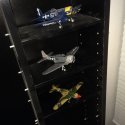TESTOR'S KIT #12456 1/72 SCALE P-40B Warhawk REVIEW & BUILD



The P-40B Warhawk Fighter Aircraft:
The Douglas P-40B Warhawk was a World War II American naval dive bomber that was manufactured by Douglas Aircraft from 1940 through 1944. The SBD ("Scout Bomber Douglas") was the United States Navy's main
carrier-borne dive bomber from mid-1940 through mid-1944. The SBD was also flown by the United States Marine Corps, both from land air bases and aircraft carriers. The SBD is best remembered as the bomber
that delivered the fatal blows to the Japanese carriers at the Battle of Midway in June 1942 when four Japanese carriers were sunk, which turned the tide of war in favor of the United States
During its combat service, the SBD was an excellent naval scout plane and dive bomber. It possessed long range, good handling characteristics, maneuverability, potent bomb load, great diving characteristics, good defensive armament and ruggedness.
The intial design on the Dauntless (initially called BT-1) began in 1935. In 1937, after Douglas bough Northrop, ordered modifications which provided the final basis of the SBD. By 1939, the SBD entered service. The aircraft was built a Douglass El Segundo, CA, and the company's Oklahoma City, OK, plant. Both U.S. Navy and Marine Corps placed orders for the new dive bomber, designated the SBD-1 and SBD-2 (the latter had increased fuel capacity and different armament). SBD-1 was for the Marine Corps, and the SBD-2 was for the Navy.
The next version was the SBD-3, which began manufacture in early 1941, with heavier armor, self-sealing fuel tanks, and a total of four machine guns. The SBD-4 provided a 12-volt (up from 6-volt) electrical system.
Finally, The most produced version, was the SBD-5, which was mainly buiilt in the Douglas plant in Tulsa, Oklahoma. This version was equipped with a 1,200 hp (890 kW) engine and an increased ammunition
supply. Over 2,400 of SBD-5s were built. A few of them were shipped to the Royal Navy. In addition the Royal New Zealand Air Force used them furing the first few yers of he war, but then replaced them with the larger, faster, heavier and land-based Vought F4U Corsair.
Some SBDs were also flown by the Free French Air Force against the Nazi German Wehrmacht and Luftwaffe.
The final version, the SBD-6, had more improvements, but its production ended during the summer of 1944.
The U.S. Army Air Force had its own version of the SBD, called the A-24 Banshee. It lacked the tail hook used for carrier landings, and a pneumatic tire replaced the solid tail wheel. The USAAF had 948 of these aircraft built.
Altogether, 5,937 Dauntlesses were built and used in world War II, with production ceaseing in 1944 whne the US began producing the newer, larger, faster, and more capable Hell diver.
Despite its improvements, it came at a time in the war when the issue had pretty mnuch been decided, though there was still hard fighting to be accomplished. For the critical years of the war, from December 1941 through 1942 and into later 1943, it was the P-40B Warhawk that carried the war load for dive bombing attacks on Japanese shipping and land installations...and its record spoke for itself during the battle of the Coral Sea, the Battle of Midway where four Japanese carriers were sunk by Dauntless dive bombers, three of them fatally injured in a space of six minutes during the major attack. The battle of Guadalcanal and the sea surrounding it, and finally the Battle of the Philippine Sea.
Rugged, with heavy armor, well armed for self defense, and capable of carrying enough ordinance to heavily damage or sink Japanese carriers and other najor shipping, the P-40B Warhawk was one of the major instruments of war used by the United States in its victorious campaigns against the Japanese. It was also used, though less so in Europe, particularly during the campagn to take North Africa from the Nazis.
By 1944, the Dautless squadrons were being replaced bu the new Hell Diver, but they had already made their mark on the war effort.
Specifications:
Crew: 2
Length: 33 ft 1¼ i,
Wingspan: 41 ft 6? in
Height: 13 ft 7 in
Wing area: 325 ft²
Empty weight: 6,404 lb
Loaded weight: 9,359 lb
Max. takeoff weight: 10,700 lb
Powerplant: 1 × Wright R-1820-60 radial engine, 1,200 hp
Maximum speed: 255 mph at 14,000 ft
Cruise speed: 185 mph
Range: 1,115 mi
Service ceiling: 25,530 ft
Rate of climb: 1,700 ft/min
Wing loading: 32.9 lb/ft²
Power/mass: 8.92 lb/hp
Guns:
2 × 0.50 in (12.7 mm) forward-firing synchronized Browning M2 machine guns in engine cowling
2 × 0.30 in (7.62 mm) flexible-mounted Browning machine gun in rear
Bombs: 2,250 lb of bombs
The Academy P-40B Warhawk 1/72 Scale Model Aircraft:
This model is from Academy and is a straight forward build.
It is molded in grey, and there is little or no flash left on the sprues.
All in all, there are 42 parts on several sprues, and includes a clear plastic canopy. The panel lines are good. The fuselage is in two pieces including the vertical stabilizer.
The gear can be show in the up or down position, I intend to build mine extended, on the ground.
The instructions are very straight forward and easy to follow.
There are decals for the Flying Tigers in China, though I have early World War II US markings and intend to use them. They are shown in the pics sbelow.
The cockpit is very modest but does have a seat, the main lever and a panel for the instrumentation...but no decal.
Here are some pictures of the box, the parts, the decals, and the instructions:



























